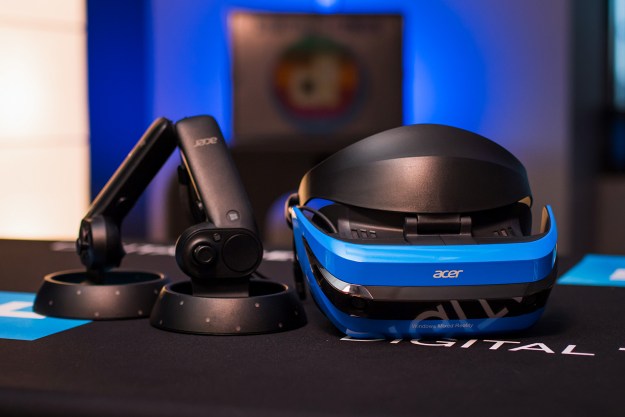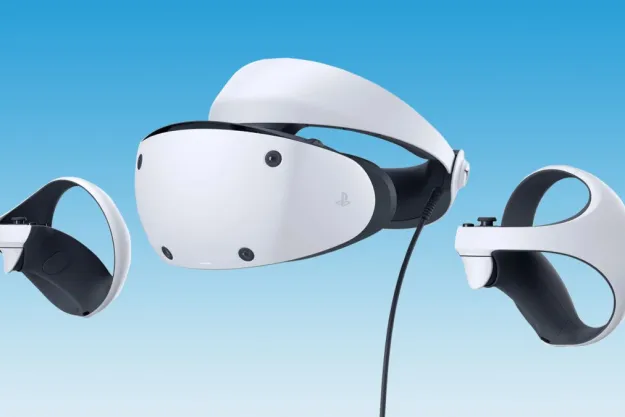
“The first Windows Mixed Reality headset can't fulfill its promise.”
- High resolution display
- Easy setup
- Inside-out tracking
- Uncomfortable
- Limited game selection
- Not price competitive
- Unintuitive controllers
After making a big splash in 2016 with the HTC Vive and Oculus Rift, the virtual reality market has been quietly moving toward the next generation of flagship headsets. Since the Rift and Vive, we’ve seen a handful of alternatives enter the fray, like the Google Daydream and PSVR — but it’s been a while a brand-new PC VR headset hit the market.
Microsoft aims to change that with its Mixed Reality platform, offering manufacturers like Acer, Dell, and Samsung the technology and software compatibility they need to break into the PC VR space. Microsoft wants Windows Mixed Reality to become the third major player in the VR space.
At $400, the Acer Mixed Reality headset comes with everything you need to get started — two touch controllers, the headset, and even batteries for the controllers. That’s it. There aren’t any external sensors to worry about here. The headset features inside-out tracking, so it uses two front-mounted sensors to detect your position in space, rather than external units like the Vive and Rift.
The Acer headset is a neat, tidy little package — but can it really be a challenger to the two undisputed champions of the VR space? Well, let’s dig into the Acer Mixed Reality headset review and find out.
Click-Clack
The first thing you’ll notice about Acer’s Mixed Reality Headset is its atypical color scheme. The Vive and Rift are both matte black and sleek, while the Acer is glossy blue with just a few black accents. It’s nice to see some color.
Unfortunately, the design leaves much to be desired. The Acer Mixed Reality Headset feels like it was snapped together, and would break apart if you dropped it. Oculus’ Rift and HTC’s Vive feel far more expensive. For instance, the headband is rigid plastic, and the wheel used to tighten or loosen it makes sharp, disconcerting clicks when adjusted.
That sharp plastic click shows up in other places, too. The headset can also lift up like a visor, which is nice, but makes the same sharp “oh no, did I break it?” noise every time. It’s not a sound you want a $400 device to make.
Unlike its peers, the Acer is a glossy blue headset with a few black accents — a refreshing change.
Because there’s only one way to adjust fit, with the click-wheel on the back, we found it hard to get the headset into focus. The Rift and Vive have a few different straps you can use to customize the fit, so the headset’s lenses are properly in focus, without having to wrestle with the way it rests on your nose.
Getting the Rift to focus, for instance, is just a matter of moving it up or down on your face, then tightening a strap so it rests there on its own. For the Acer headset, we found ourselves constantly re-adjusting the position. It never felt, or looked, quite right.
The frontal padding, which separates the hard plastic of the headset from your face and the bridge of your nose is thin and flimsy — like the foam covering on a pair of cheap headphones. Additionally, like most VR headsets, it’s not the most breathable, so it gets pretty warm after a while. That’s where the flip-up visor comes in handy — it’s nice to be able to pop out of VR and let your face breath for a few minutes.
But flipping the visor up puts the full weight of the headset is on the top part of the headband, so it will invariably slip down your forehead. That means re-adjusting the whole thing. Again.
Breezy setup
While its not the most comfortable, Acer’s Mixed Reality Headset is at least easy to setup – which bodes well for Windows Mixed Reality overall. Just plug it into your computer via a single HDMI and USB port. There’s no external box, or external power. If your Windows 10 install is up to date, it’ll open the Mixed Reality Portal automatically. If you do need any additional updates, Windows will gleefully prompt you to install them.
The Mixed Reality Portal guides you through the initial setup steps, which include deciding if you want to setup a room-scale experience, or stay seated when you use your headset. If you opt to setup a room scale area, you’ll be asked to move your headset around in a square to set the boundaries of your VR space.
Next up, it’ll ask you to setup your controllers. This part is kind of a pain because of a design flaw in the controllers themselves — the Bluetooth Pairing button is only accessible with the battery covers off. So, to pair your controllers, you need to open them up, hold the batteries in so they don’t fall out, then click and hold a weird little button till the controller enters pairing mode. Then pop the cover back on, and do the same thing for the other controller.
If your batteries are lower than you anticipated during this step, there’s no warning, you’ll just have to pair and re-pair until you figure out what’s wrong. It’s not a great experience, so make sure you’re using brand-new or fully charged batteries for the initial setup.
When your controllers’ battery runs low, it’ll just disconnect.
After that, you’re good to go. No need to calibrate anything, or reposition sensors, or anything else.
By contrast, to set up the HTC Vive, you will need three power adapters, and three power outlets — two for the external sensors, and one for the headset itself. The headset needs to be plugged into a separate device which itself plugs into your PC, and that’s all just the hardware setup. Next, you must run the software setup, which will likely involve you repositioning your external sensors so they can see your headset and controllers without any interference. The Oculus Rift uses a similar setup process if you own the Touch controllers.
With the Acer Mixed Reality headset though, you just plug it in and the tutorial takes care of the rest. It’s a setup process you can do confidently if you’ve never even seen a VR headset before.
Useful, but strangely shaped controllers
Like the Oculus Rift and HTC Vive, the Acer Mixed Reality headset comes with a pair of touch controllers. You can also use an Xbox 360 or Xbox One controller, but the headset tracks the touch controllers, so they’re a little easier to use than a standard controller.
Their design blends elements from the Vive and Rift touch controllers, with a flat angled grip and circular constellation tracking ring on the end. These don’t track your finger positions like the Rift controllers, and they don’t feel as sturdy and reliable as the Vive controllers.
Again, there’s an issue here with the plastic used to build the controllers. The tracking rings have just a bit too much flex, and they feel like they’re one good drop away from breaking. Even with the weight added by a pair of AA batteries in each controller, they feel too light and insubstantial.
The HTC Vive controllers feel weightier in your hand, and their layout is a bit more intuitive. It’s easier to find each button without looking down at the controllers than it is with the Windows Mixed Reality controllers. The Oculus Rift’s touch controllers still steal the show. They’re more substantial, and your fingers will know where to rest from the first time you pick them up. The build quality eclipses the Mixed Reality controllers with ease.
On the plus side, most of the Windows Mixed Reality experiences show the Mixed Reality controllers in VR space, which is helpful if you need to set them down for any reason. However, because of the inside-out tracking the headset uses, you might lose the controllers if you look away from them.
Which brings us to one crucial flaw — battery life. The controllers don’t burn through batteries any faster than their Vive and Rift counterparts, but the Windows Mixed Reality platform doesn’t do a very good job of communicating how much battery life you have left. The controllers will simply disconnect when they’re dry. You can, however, enter VR, and flip the controllers over in your hands, and it’ll show you a battery meter. Otherwise, you’ll have to leave VR, open the Mixed Reality Portal, then click on the Controllers tab, where it will then tell you which controller is low on battery.
Higher resolution, lower field of view
Internally, the Acer Mixed Reality Headset features a maximum resolution of 2,880 x 1,440, which is slightly higher than the Vive and Rift, both of which top out at 2,160 x 1,200. It’s an improvement, but it’s not one you’re going to notice. Why? Because of a couple important details.
Don’t expect to have a good time browsing the web in VR.
First up, the Acer Mixed Reality Headset — and to be fair, every other VR headset on the market right now — still suffers from a pronounced screen-door effect. Because there are two tiny screens only a few inches from your face, and they’re warped by internal lenses that give the illusion of visual immersion, you’re able to easily discern individual pixels in bright environments.
For instance, when you first set up the Acer headset, you’re dropped into the Microsoft Mixed Reality Hub, a swanky mountaintop condo with giant screens on each wall. Those screens can open into web browsers, the Windows Store, or a variety of other applications. However, when you open an application like a web browser, the screen door effect becomes even more pronounced. Against a white background with black text, the screen door effect is not only more visible than it is during games or immersive experiences, and it actively interferes with your ability to comfortably read for even short periods of time. Even making it through a short news article can be – literally – painful.
Again, it’s important to point out this is something every VR headset suffers from, and they’ll continue to suffer from it for the foreseeable future. It’s not a problem in most games — just don’t expect to have a good time browsing the web in VR.
The Acer Mixed Reality Headset might feature displays that are higher resolution than its competitors, but it falls behind in one important metric — field of view. By offering a maximum field of view of 100 degrees, the Acer headset isn’t quite as immersive as the Vive or Rift, both of which feature 110 degrees of vision. All three headsets feature the same maximum refresh rates though, topping out at 90Hz.
Growing pains
The Windows Mixed Reality Hub, that stylish mountaintop condo we mentioned, offers all the basic functionality you’d expect from a VR hub. You can decorate your home, launch apps, browse the Windows Store, and launch a few different applications in VR. If you hate yourself, you can even surround yourself with Twitter windows, so you’re fully immersed in current events – at all times, with no escape.
While it looks good, the Windows Mixed Reality Hub doesn’t do a good job of communicating everything you can do with it. After setup and a brief tutorial that teaches you how to get around in VR, you’re plopped into the middle of your VR living room. The platform doesn’t explain how to launch external apps, which apps are supported, how to browse the web (with Edge of course — you can’t use Chrome), or how to direct Cortana to search for things for you.
That’s right — Windows Mixed Reality is compatible with Cortana. You even get the option to enable her during setup. You’ll go through a brief Cortana tutorial but it’s very brief. It doesn’t explain how to use Cortana to fill out fields in a web browser, or how to bring up a keyboard to enter your username and password in applications that require it.
The Mixed Reality Hub isn’t a bad start, but it isn’t as easy to understand as Oculus Home — not by a long shot.
Where’s the mixed reality?
There’s a good selection of games available on the Windows Store, but currently that’s all you get with the Acer Mixed Reality Headset. SteamVR support is coming soon — likely around the holiday season — so you’ll have to wait a while to get a full VR experience out of the Acer headset.
There’s nothing unique here that other headsets can’t offer – nothing yet, anyway.
What’s currently available is a limited selection of games and VR experiences. One notable absence? Mixed Reality. We couldn’t find any mixed reality experiences available — those front-facing sensors are just sensors for now, not pass-through cameras you can use to layer virtual elements over your real world.
It’s disappointing, given how heavily Microsoft has promoted Windows Mixed Reality as something different from VR. There’s nothing unique here that other headsets can’t offer – nothing yet, anyway.
Our Take
Compared to the HTC Vive and Oculus Rift, which have had more than a year to mature into fully-featured immersive VR platforms, the Acer Windows Mixed Reality Headset feels half-baked.
That said, there’s some potential here. Inside-out tracking, easy setup, approachable price — these things are sure to endear new users to VR, even if the hardware and software won’t. So, should you buy the Acer Mixed Reality Headset in hopes that Windows Mixed Reality will mature, like other VR platforms have?
Is there a better alternative?
Yes, the Oculus Rift, HTC Vive, and even PSVR. Each of these three options offers up everything that’s missing from the Acer Mixed Reality Headset. They have mature platforms with a lot of games and experiences, they’re well-built and comfortable, and they’re simply a joy to use. Acer also has competitors in the Samsung Odyssey and Dell Visor. We have yet to fully test these alternatives, but we think they’ll prove stiff competition for the Acer headset.
Granted, the Acer headset is affordable. The Vive is more expensive than the Acer headset, coming in at $600, and the PSVR headset is $400 on its own. If you don’t have a PlayStation 4 or PlayStation 4 Pro, you’re looking at another $300 or $400, respectively.
What about the Oculus Rift? Well we’re glad you asked! After recent price cuts, the Rift is the same price as the Acer Mixed Reality Headset. Setup is a little more complex, and you do have to setup an external sensor, but it provides a much better experience, and its touch controllers are lightyears ahead of the Windows Mixed Reality Controllers.
How long will it last?
The Windows Mixed Reality platform is Microsoft’s next big consumer electronics push, so investing in a compatible headset isn’t a bad bet. It’s going to be around for a while, and it’s only going to get better. However, as the platform gets better, so will the headsets. We think you’re better off holding out and waiting for the next generation.
Should you buy it?
Not right now. The Oculus Rift is clearly a better pick. It’s the same price, it’s a better headset, it has better software, it’s much more pleasant to use and, perhaps most importantly, it’s more comfortable. Windows Mixed Reality might be a worthy investment at some point in the future, but it’s not there yet.
Updated 11-10-17 to include information about the in-VR battery gauges.








